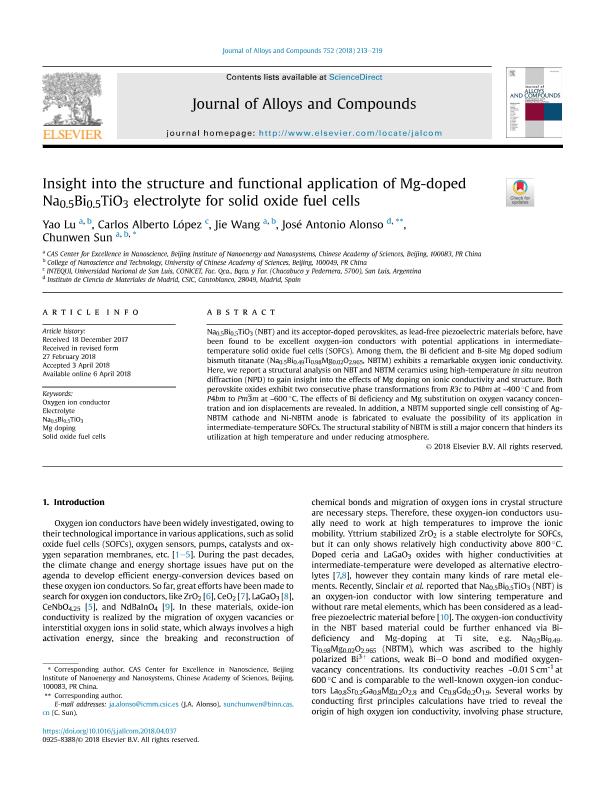Mostrar el registro sencillo del ítem
dc.contributor.author
Lu, Yao
dc.contributor.author
Lopez, Carlos Alberto

dc.contributor.author
Wang, Jie
dc.contributor.author
Alonso, José Antonio
dc.contributor.author
Sun, Chunwen
dc.date.available
2019-10-18T21:48:26Z
dc.date.issued
2018-07
dc.identifier.citation
Lu, Yao; Lopez, Carlos Alberto; Wang, Jie; Alonso, José Antonio; Sun, Chunwen; Insight into the structure and functional application of Mg-doped Na 0.5 Bi 0.5 TiO 3 electrolyte for solid oxide fuel cells; Elsevier Science Sa; Journal of Alloys and Compounds; 752; 7-2018; 213-219
dc.identifier.issn
0925-8388
dc.identifier.uri
http://hdl.handle.net/11336/86518
dc.description.abstract
Na0.5Bi0.5TiO3 (NBT) and its acceptor-doped perovskites, as lead-free piezoelectric materials before, have been found to be excellent oxygen-ion conductors with potential applications in intermediate temperature solid oxide fuel cells (SOFCs). Among them, the Bi deficient and B-site Mg doped sodium bismuth titanate (Na0.5Bi0.49Ti0.98Mg0.02O2.965, NBTM) exhibits a remarkable oxygen ionic conductivity. Here, we report a structural analysis on NBT and NBTM ceramics using high-temperature in situ neutron diffraction (NPD) to gain insight into the effects of Mg doping on ionic conductivity and structure. Both perovskite oxides exhibit two consecutive phase transformations from R3c to P4bm at ~400 C and from P4bm to Pm3m at ~600 C. The effects of Bi deficiency and Mg substitution on oxygen vacancy concentration and ion displacements are revealed. In addition, a NBTM supported single cell consisting of Ag- NBTM cathode and Ni-NBTM anode is fabricated to evaluate the possibility of its application in intermediate-temperature SOFCs. The structural stability of NBTM is still a major concern that hinders its utilization at high temperature and under reducing atmosphere.
dc.format
application/pdf
dc.language.iso
eng
dc.publisher
Elsevier Science Sa

dc.rights
info:eu-repo/semantics/openAccess
dc.rights.uri
https://creativecommons.org/licenses/by-nc-sa/2.5/ar/
dc.subject
Oxygen ion conductor
dc.subject
Electrolyte
dc.subject
Na0.5Bi0.5TiO3
dc.subject
Mg doping
dc.subject
Solid oxide fuel cells
dc.subject.classification
Química Inorgánica y Nuclear

dc.subject.classification
Ciencias Químicas

dc.subject.classification
CIENCIAS NATURALES Y EXACTAS

dc.title
Insight into the structure and functional application of Mg-doped Na 0.5 Bi 0.5 TiO 3 electrolyte for solid oxide fuel cells
dc.type
info:eu-repo/semantics/article
dc.type
info:ar-repo/semantics/artículo
dc.type
info:eu-repo/semantics/publishedVersion
dc.date.updated
2019-10-15T17:31:08Z
dc.journal.volume
752
dc.journal.pagination
213-219
dc.journal.pais
Países Bajos

dc.journal.ciudad
Amsterdam
dc.description.fil
Fil: Lu, Yao. Chinese Academy of Sciences; República de China
dc.description.fil
Fil: Lopez, Carlos Alberto. Consejo Nacional de Investigaciones Científicas y Técnicas. Centro Científico Tecnológico Conicet - San Luis. Instituto de Investigaciones en Tecnología Química. Universidad Nacional de San Luis. Facultad de Química, Bioquímica y Farmacia. Instituto de Investigaciones en Tecnología Química; Argentina. Universidad Nacional de San Luis. Facultad de Química, Bioquímica y Farmacia. Área Química General e Inorgánica; Argentina
dc.description.fil
Fil: Wang, Jie. Chinese Academy of Sciences; República de China
dc.description.fil
Fil: Alonso, José Antonio. Consejo Superior de Investigaciones Científicas; España. Instituto de Ciencia de Materiales de Madrid; España
dc.description.fil
Fil: Sun, Chunwen. Chinese Academy of Sciences; República de China
dc.journal.title
Journal of Alloys and Compounds

dc.relation.alternativeid
info:eu-repo/semantics/altIdentifier/url/https://www.sciencedirect.com/science/article/pii/S0925838818313239
dc.relation.alternativeid
info:eu-repo/semantics/altIdentifier/doi/https://doi.org/10.1016/j.jallcom.2018.04.037
Archivos asociados
